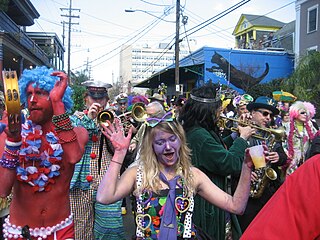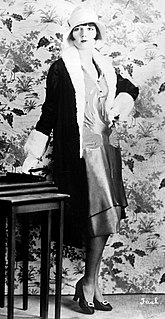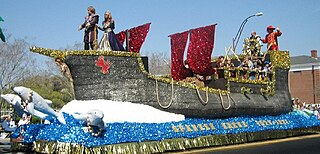
A krewe is a social organization that puts on a parade or ball for the Carnival season. The term is best known for its association with Mardi Gras celebrations in New Orleans, but is also used in other Carnival celebrations around the Gulf of Mexico, such as the Gasparilla Pirate Festival in Tampa, Florida, and Springtime Tallahassee, as well as in La Crosse, Wisconsin, and at the Saint Paul Winter Carnival.
The Mistick Krewe of Comus, founded in 1856, is a New Orleans, Louisiana Carnival krewe. It is the oldest continuous organization of New Orleans Mardi Gras festivities.

The holiday of Mardi Gras is celebrated in all of Louisiana, including the city of New Orleans. Celebrations are concentrated for about two weeks before and through Shrove Tuesday, the day before Ash Wednesday. Usually there is one major parade each day ; many days have several large parades. The largest and most elaborate parades take place the last five days of the Mardi Gras season. In the final week, many events occur throughout New Orleans and surrounding communities, including parades and balls.

Joseph Stillwell Cain, Jr. is largely credited with initiating the modern way of observing Mardi Gras and its celebrations in Mobile, Alabama, following the Civil War. In 1868, following a visit the previous year to New Orleans and while Mobile was still under Union occupation, Joe Cain paraded through the streets of Mobile, dressed in improvised costume as a fictional "Chickasaw" chief named Slacabamorinico. The choice was an attempt to insult to U.S. Army forces in that it was believed by some that the Chickasaw tribe had never been defeated in war. Joe was joined at some point by six other Confederate veterans, parading in a decorated coal wagon, playing drums and horns, and the group became the "L. C. Minstrel Band", now commonly referred to as the "Lost Cause Minstrels" of Mobile.

Lundi Gras is a relatively recently popularized name for a series of Shrove Monday events taking place during the Mardi Gras. It includes the tradition of Rex, king of the New Orleans carnival,and Zulu King arriving by boat. This began in 1874, but the term Lundi Gras was not widely applied until 1987 when the arrival was brought back as part of a series of river-related events under the name of "Lundi Gras". Lundi Gras was the creation of journalist Errol Laborde. The event was staged with the cooperation of Riverwalk Marketplace and its then marketing director Carol Thistle Lentz. The events are detailed in Laborde's book, Krewe: The Early New Orleans Carnival from Comus to Zulu.

The Mardi Gras mystic society of Cain’s Merry Widows was founded in 1974 in Mobile, Alabama, home of the first Mardi Gras in America (1703). Each Mardi Gras,The ladies, known variously as "The Merry Widows of Joe Cain", "Joe Cain's Widows", or even just as "The Widows" gather on Joe Cain Day ,clothed in black mourning clothes with veils, to lay a wreath at Cain’s burial site at Church Street Graveyard, wail over their "departed husband's" grave, then travel to Joe Cain’s former house on Augusta Street to offer a toast and eulogy to their "Beloved Joe".
Mardi Gras refers to events of the Carnival celebrations, beginning on or after Epiphany and culminating on the day before Ash Wednesday.

The State Fair Meadowlands is a carnival held every summer at the Meadowlands Sports Complex in East Rutherford, New Jersey. It derives its name from State Fair Stores, which run the carnival. It should also not be confused with the New Jersey State Fair, Sussex County Farm and Horse Show in Augusta, New Jersey. The fair is held in the parking lot that surrounds the MetLife Stadium and runs for two weeks in late June and early July. It attracts over 300,000 visitors per year.
The Strikers Independent Society is a mystic society founded in 1843 in Mobile, Alabama and participated in Carnival during New Year's Eve and New Year's Day celebrations. It is the oldest remaining mystic society in America but no longer hosts an annual parade.

Mardi Gras is the annual Carnival celebration in Mobile, Alabama. It is the oldest annual Carnival celebration in the United States, started by Frenchman Nicholas Langlois in 1703 when Mobile was the capital of Louisiana. This was fifteen years before New Orleans was founded, although today their celebrations are much more widely known for all the current traditions such as masked balls, parades, floats and throws were first created there. From Mobile being the first capital of French Louisiana (1702), the festival began as a French Catholic tradition. Mardi Gras in Mobile has now evolved into a mainstream multi-week celebration across the spectrum of cultures in Mobile, becoming school holidays for the final Monday and Tuesday, regardless of religious affiliation.
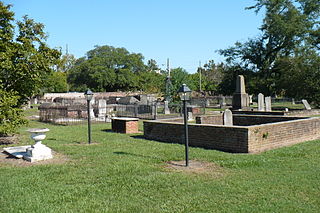
Church Street Graveyard is a historic city cemetery located in Mobile, Alabama. The cemetery is situated on 4 acres (1.6 ha) and is surrounded by a brick wall that dates to 1830. At the time that the cemetery was established it lay about a half mile away from most development, but it is now considered to be in downtown.

Mardi Gras throws are strings of beads, doubloons, cups, or other trinkets passed out or thrown from the floats in the New Orleans Mardi Gras, the Mobile Mardi Gras and parades all throughout the Gulf Coast of the United States, to spectators lining the streets. The "gaudy plastic jewelry, toys, and other mementos [are] tossed to the crowds from parading floats". "The goodies, or 'throws,' consist of necklaces of plastic beads, coins called doubloons, which are stamped with krewes' logos, parade themes and the year, plus an array of plastic cups and toys such as Frisbees or figurines". The cups that are used as throws are sometimes referred to as New Orleans dinnerware.
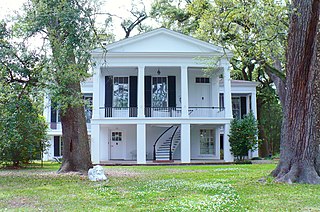
Oakleigh is a c. 1833 historic house museum in Mobile, Alabama, United States. It is the centerpiece of the Oakleigh Historic Complex, a grouping of buildings that contain a working-class raised cottage, Union Barracks, and a modern archives building. The name for the estate comes from a combination of the word oak and the Anglo-Saxon word lea, that means meadow. The complex is within the Oakleigh Garden Historic District, the surrounding district and neighborhood being named after the estate.
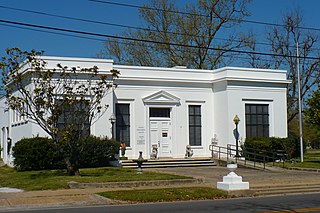
The National African American Archives and Museum, formerly known as the Davis Avenue Branch of Mobile Public Library, is an archive and history museum located in Mobile, Alabama. It serves as a repository for documents, records, photographs, books, African carvings, furniture, and special collections that relate to the African-American experience in the United States. Some of the collection was developed when the building was part of the Mobile Public Library as the Davis Avenue Branch.

Mardi Gras in the United States is not observed nationally across the country, however a number of cities and regions in the U.S. have notable Carnival celebrations. Most trace their Mardi Gras celebrations to French, Spanish, and other colonial influences on the settlements over their history. The earliest Carnival celebration in North America occurred at a place on the west bank of the Mississippi river about 60 miles downriver from where New Orleans is today; this Mardi Gras on the 3rd of March 1699 and in honor of this holiday, Pierre Le Moyne, Sieur d'Iberville, a 38-year-old French Canadian, named the spot Point du Mardi Gras near Fort Jackson. The earliest organized Carnival celebrations occurred in Mobile, Biloxi, New Orleans, and Pensacola, which have each developed separate traditions. In addition, modern activities generally vary from city to city across the U.S.

The Parc de Belleville, one of the parks and gardens of the 20th arrondissement of Paris, is situated between the Parc des Buttes-Chaumont and the Père Lachaise Cemetery.

Mardi Gras World is a tourist attraction located in New Orleans. Guests tour the 300,000 square foot working warehouse where floats are made for Mardi Gras parades in New Orleans. Mardi Gras World is located along the Mississippi River, next to the Morial Convention Center. Their events venue, the River City Complex, also hosts festivals, weddings, private parties and corporate events.


